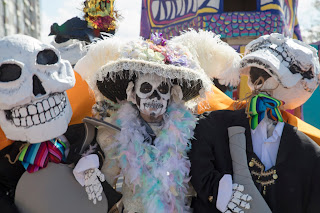For a sentence as simple as, “May I take your picture?” I am often surprised by how much drama it can manifest for photographers. For starters, the words themselves make so very many photographers utterly uncomfortable. It’s like we can’t even say them. The words, why, they just don’t fall from our lips. It’s not an easy task to get them out. If that were not bad enough, even if you do manage to sputter and spew them out, the response can be overwhelming. I think there are few topics as difficult for a beginner, heck even a pro sometimes, to master, yet this skill strikes at the very core, the essence if you will, of what we do. Even if you do not take pictures of people, at some point in your photographic career, you’re going to have to ask somebody for permission to take a picture of something and this can catapult you into the complex world of dealing with people’s emotions. I’ll be the first to admit that, even when the process appears to work smoothly, it can be daunting and leave you feeling unnerved.
It’s very complicated yet somehow easy as pie at the same time. It seems easy. It seems like it should be the easiest thing in the world, to just walk up to somebody and ask, “May I take your picture?” yet, somehow you can get these words so easily caught in your throat. We know it’s a skill we need to master yet, somehow, when it’s time to do it, we pause. It can be really hard to actually do.
A while back, I went shooting with a friend of mine. He is one of those photographers, I’ve known him a while and he’s really pretty good. He came up through the ranks about the same time I did, even studied under some of the same people I did. We are friends, if for nothing else than we’ve been shooting buddies for the better part of twenty years. I consider him competent, if not seasoned as a photographer. While we we out shooting, I happened to notice that he simply could not ask permission to photograph anybody we encountered that day. We had been out walking around, strange city for both of us, and I had decided I wanted to do some street type shooting, a bit more portrait oriented from what I usually shoot. He’s a buildings guy too, there’s no harm in that but, when I told him my plan of doing some portraits, he jumped at the opportunity. As we were walking, I got into the routine, into the flow if you will, of stopping, chatting people up, asking, “May I take your picture?” He had a really hard time doing it. He would either try to sort of “mooch” off the opportunity, taking the same shots I did, after I had taken them, or he would just fall back and not shoot at all. At one point, I realized he just couldn’t get the words out. I was a bit taken aback by this, as I thought of him a better photographer, but he just couldn’t do it. He couldn’t say those magical little words, “May I Take Your Picture?” The words, why, they just wouldn’t come. I was shocked that somebody who was totally capable of climbing around musty old buildings and the like couldn’t simply walk up to a random person and ask a simple question but there you have it. And, I really can’t criticize him, as it’s not always an easy thing for me to do myself. Perhaps working with models and attending a bunch of workshops has gotten me over my fear in this regard but I can recall a time in my own not too distant past when I too was morbidly afraid of those simple little words, “May I take your picture?” It’s like kryptonite to otherwise very superman photographers.
It can be a really difficult technique to master, asking that is. Now, I can teach you all about aperture and you might take a while to learn that but, once you know it, you kind of get it down. This business of dealing with people though, man, it never seems the same from case to case and you never really feel like you are fully comfortable. As soon as you feel like you’ve got it, somebody or something throws a wrench into the works and, boom, you are back at square one. I have found in my travels that there are a few tips I can offer. Maybe these will help, maybe they won’t. I do wish you the best of luck in either case. Anyway, here goes.
1. You are going to have to ask. Repeat after me: you are going to have to ask. You are going to have to ask somebody at some point so you might as well accept that fact and practice in the mirror if you have to. Ask your friends. Ask you dog. Ask your dog’s friends. You get the idea. Just ask. Get over yourself and ask already. Accept this and move on. OK, here we go….this is us moving on then.
2. Somebody might say, “No!” Newsflash, not everybody likes having their picture taken. Perhaps we are afraid of failure and this is why we don’t want to ask but, see #1, you have to ask. Once you start asking, well it naturally follows that you are going to get a “No!” every now and again. Maybe sooner, maybe later but, yes, Virginia, there really is a “No!” in your future too. My advice here? Accept this and move on. I like to respect people’s wishes, so I don’t push. I tend to ask but not push. If you are the pushy type, why more power to you, I guess. For myself? No means, well, no. I accept it and move on. I don’t have to take everybody’s picture and there are plenty of fish in the sea as it were.
3. You can shoot first and ask questions later. This is something people often forget. When I teach or even go out with fellow shooters, I’m surprised by how many people don’t practice this. I get asked a lot of times, “but, how do you get a candid shot if you have to ask first?” For me, the answer is, “what makes you think I have to ask first?” You can shoot somebody without them seeing you then go up and ask, “May I take your picture?” It helps if, when presented with this situation you even fire off an extra shot once permission is granted, even if you don’t use it. Flash memory is cheap, finding models is not. You can always delete it later, right? And then there’s the matter of, well, what if they say, “No!” after you’ve already shot? That one’s easy too, just delete or don’t use that frame. Again, move on. Keep moving, keep shooting all the time, just slow down and ask in the middle if you have to.
4. You can ask first and shoot later. Just as with #3 above, the reverse is also true. You can strike up a conversation with somebody, ask them, “May I take your picture?” and, if they say, “Yes!” opt for a posed/canned shot. You can then follow them or wait a few minutes, even “shoot through” the situation and wait for them to relax, to catch them a bit more off guard, if you want something a bit more natural. There’s not really a rule that says once you ask, you only get 1 or 2 frames. Well, I think maybe there is but it only applies to like the Queen of England and you’re probably not shooting her anyway.
5. Somebody might say, “Yes!” I know this sounds odd, but be prepared for somebody to say, “Yes!” as well as no. They might want your business card. They might want more photos. They might have questions (“What are you going to use the pictures for?” is a pretty common one.) Sometimes your innocent little question breaks open the floodgates. Best advice here, I believe, is to just be prepared, be honest, answer their questions as best you can.
6. As my Grandmother used to say, “You Catch More Flies with Honey than you do with Vinegar.” What does this mean? Well, as my Grandmother also used to say, “it doesn’t cost a thing to be nice.” If you are anxious about asking people to take their photos, I recommend chatting them up a bit. Find something nice about a person. “That’s a pretty hat you have on” or “I like your sunglasses.” Saying something nice to people often helps break the ice. A smile and a compliment go a long way. If you are asking a person to photograph them there’s probably something that drew you to them as a subject. There really is no harm in sharing what that might be. “I love your smile” or “You’ve got bright eyes” really goes a long way. Make them feel special because, why, they are and it might just make for that something special to be captured more easily on film (or flash memory as it were.)
7. Try not to futz with your camera. Too much. Well, maybe just a little bit. What I mean by this is that, it helps if you have your camera settings down before working with somebody. It doesn’t waste their time, it doesn’t waste yours. It allows you to focus on what’s important, working the subject, as opposed to setting the ISO. I recommend you set the ISO first, when nobody is around and then only adjust what you need to once you’ve managed to wrangle up a willing subject. Having said that, I find it to be a good idea to also try a few different camera settings once I get a willing model but, here again, I try to move through settings quickly. If you don’t have a good mastery of your controls, you might want to skip this part. I will frequently try a wide open aperture, then stop it down, move slightly, watch the background, try to get a little closer, do a little dance in place to try and work the angles and the lighting a bit better. And, yes, some knobs will get tweaked here but I don’t spend the majority of my time in front of subject working dials. I like to talk to people here, especially if they have been kind enough to stop and let me work with them as a subject. Which brings me to my next point….
8. Most people can’t read minds. Communicate. What I mean by this is that you might be working a subject and even feel like you’re getting great shots but, if you don’t talk to the person, they won’t know this. It’s hard for a professional model to know if what they are doing is what you want, if it’s “right” for you or not. It’s even harder for somebody you have just randomly stopped on the street. They don’t know you. They can’t read your mind. If something is working, tell them. If something isn’t move, adjust your settings, talk with them, work with them and, if you still can’t get past it, you might just have to take what the camera gives you and move on. Move on, yes, but be thankful.
Always be thankful. It’s a wonderful thing, an honor and privilege to get to take somebody’s picture. I love doing it even if it means I have to ask first. May I Take Your Picture? Why, I hope I can someday.
Until next time…
PS This one from the Day of the Dead parade. I call it “Three Heads are Better than One.” Taken with the Canon 5ds and the walkabout lens.

